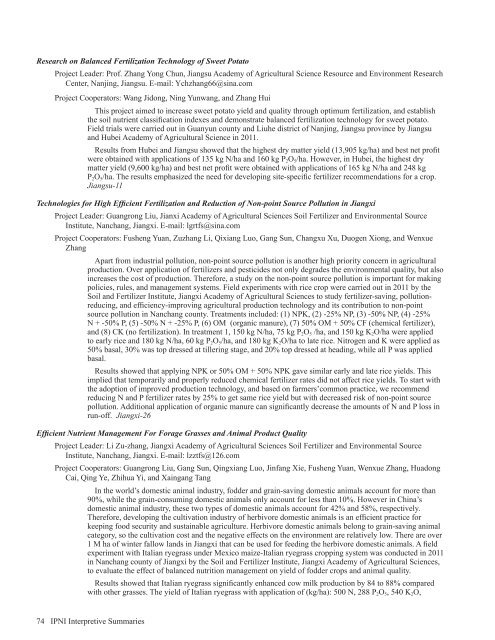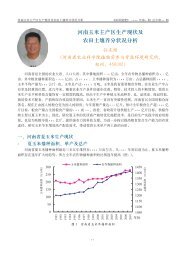Americas and Oceania Group - International Plant Nutrition Institute
Americas and Oceania Group - International Plant Nutrition Institute
Americas and Oceania Group - International Plant Nutrition Institute
You also want an ePaper? Increase the reach of your titles
YUMPU automatically turns print PDFs into web optimized ePapers that Google loves.
Research on Balanced Fertilization Technology of Sweet Potato<br />
Project Leader: Prof. Zhang Yong Chun, Jiangsu Academy of Agricultural Science Resource <strong>and</strong> Environment Research<br />
Center, Nanjing, Jiangsu. E-mail: Ychzhang66@sina.com<br />
Project Cooperators: Wang Jidong, Ning Yunwang, <strong>and</strong> Zhang Hui<br />
This project aimed to increase sweet potato yield <strong>and</strong> quality through optimum fertilization, <strong>and</strong> establish<br />
the soil nutrient classification indexes <strong>and</strong> demonstrate balanced fertilization technology for sweet potato.<br />
Field trials were carried out in Guanyun county <strong>and</strong> Liuhe district of Nanjing, Jiangsu province by Jiangsu<br />
<strong>and</strong> Hubei Academy of Agricultural Science in 2011.<br />
Results from Hubei <strong>and</strong> Jiangsu showed that the highest dry matter yield (13,905 kg/ha) <strong>and</strong> best net profit<br />
were obtained with applications of 135 kg N/ha <strong>and</strong> 160 kg P 2 O 5 /ha. However, in Hubei, the highest dry<br />
matter yield (9,600 kg/ha) <strong>and</strong> best net profit were obtained with applications of 165 kg N/ha <strong>and</strong> 248 kg<br />
P 2 O 5 /ha. The results emphasized the need for developing site-specific fertilizer recommendations for a crop.<br />
Jiangsu-11<br />
Technologies for High Efficient Fertilization <strong>and</strong> Reduction of Non-point Source Pollution in Jiangxi<br />
Project Leader: Guangrong Liu, Jianxi Academy of Agricultural Sciences Soil Fertilizer <strong>and</strong> Environmental Source<br />
<strong>Institute</strong>, Nanchang, Jiangxi. E-mail: lgrtfs@sina.com<br />
Project Cooperators: Fusheng Yuan, Zuzhang Li, Qixiang Luo, Gang Sun, Changxu Xu, Duogen Xiong, <strong>and</strong> Wenxue<br />
Zhang<br />
Apart from industrial pollution, non-point source pollution is another high priority concern in agricultural<br />
production. Over application of fertilizers <strong>and</strong> pesticides not only degrades the environmental quality, but also<br />
increases the cost of production. Therefore, a study on the non-point source pollution is important for making<br />
policies, rules, <strong>and</strong> management systems. Field experiments with rice crop were carried out in 2011 by the<br />
Soil <strong>and</strong> Fertilizer <strong>Institute</strong>, Jiangxi Academy of Agricultural Sciences to study fertilizer-saving, pollutionreducing,<br />
<strong>and</strong> efficiency-improving agricultural production technology <strong>and</strong> its contribution to non-point<br />
source pollution in Nanchang county. Treatments included: (1) NPK, (2) -25% NP, (3) -50% NP, (4) -25%<br />
N + -50% P, (5) -50% N + -25% P, (6) OM (organic manure), (7) 50% OM + 50% CF (chemical fertilizer),<br />
<strong>and</strong> (8) CK (no fertilization). In treatment 1, 150 kg N/ha, 75 kg P 2 O 5 /ha, <strong>and</strong> 150 kg K 2 O/ha were applied<br />
to early rice <strong>and</strong> 180 kg N/ha, 60 kg P 2 O 5 /ha, <strong>and</strong> 180 kg K 2 O/ha to late rice. Nitrogen <strong>and</strong> K were applied as<br />
50% basal, 30% was top dressed at tillering stage, <strong>and</strong> 20% top dressed at heading, while all P was applied<br />
basal.<br />
Results showed that applying NPK or 50% OM + 50% NPK gave similar early <strong>and</strong> late rice yields. This<br />
implied that temporarily <strong>and</strong> properly reduced chemical fertilizer rates did not affect rice yields. To start with<br />
the adoption of improved production technology, <strong>and</strong> based on farmers’common practice, we recommend<br />
reducing N <strong>and</strong> P fertilizer rates by 25% to get same rice yield but with decreased risk of non-point source<br />
pollution. Additional application of organic manure can significantly decrease the amounts of N <strong>and</strong> P loss in<br />
run-off. Jiangxi-26<br />
Efficient Nutrient Management For Forage Grasses <strong>and</strong> Animal Product Quality<br />
Project Leader: Li Zu-zhang, Jiangxi Academy of Agricultural Sciences Soil Fertilizer <strong>and</strong> Environmental Source<br />
<strong>Institute</strong>, Nanchang, Jiangxi. E-mail: lzztfs@126.com<br />
Project Cooperators: Guangrong Liu, Gang Sun, Qingxiang Luo, Jinfang Xie, Fusheng Yuan, Wenxue Zhang, Huadong<br />
Cai, Qing Ye, Zhihua Yi, <strong>and</strong> Xaingang Tang<br />
In the world’s domestic animal industry, fodder <strong>and</strong> grain-saving domestic animals account for more than<br />
90%, while the grain-consuming domestic animals only account for less than 10%. However in China’s<br />
domestic animal industry, these two types of domestic animals account for 42% <strong>and</strong> 58%, respectively.<br />
Therefore, developing the cultivation industry of herbivore domestic animals is an efficient practice for<br />
keeping food security <strong>and</strong> sustainable agriculture. Herbivore domestic animals belong to grain-saving animal<br />
category, so the cultivation cost <strong>and</strong> the negative effects on the environment are relatively low. There are over<br />
1 M ha of winter fallow l<strong>and</strong>s in Jiangxi that can be used for feeding the herbivore domestic animals. A field<br />
experiment with Italian ryegrass under Mexico maize-Italian ryegrass cropping system was conducted in 2011<br />
in Nanchang county of Jiangxi by the Soil <strong>and</strong> Fertilizer <strong>Institute</strong>, Jiangxi Academy of Agricultural Sciences,<br />
to evaluate the effect of balanced nutrition management on yield of fodder crops <strong>and</strong> animal quality.<br />
Results showed that Italian ryegrass significantly enhanced cow milk production by 84 to 88% compared<br />
with other grasses. The yield of Italian ryegrass with application of (kg/ha): 500 N, 288 P 2 O 5 , 540 K 2 O,<br />
74 IPNI Interpretive Summaries

















